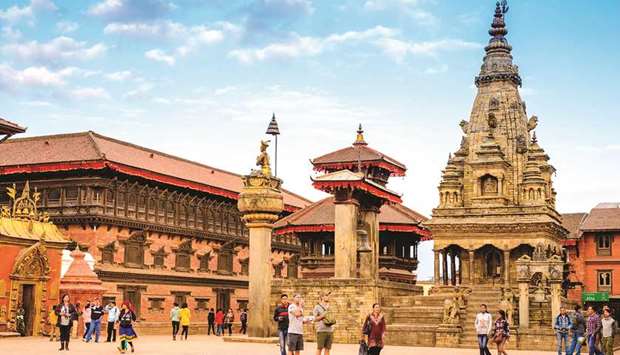Located in between China and India, along the foothills of Mount Everest, Nepal is considered having political flux and low economic growth. Although Nepal has some breathtakingly beautiful attractions for tourists, the plan to cater tourists from around the world is still to be exploited. Tourism contributes just around 5 percent to the country’s GDP.
The Himalayan range that passes through the northern part of the country bordering Tibet, autonomous region of China, is considered as one of the best eye catching regions of the world. This time we bring you not the Himalayas, but the two spots around Kathmandu and a serene lake in the remote west.
Nagarkot, 32km afar from Kathmandu, bustling capital city with its notorious dust and smoke, is famous for its beautiful sunrise, a perpetual dawn, with the sun hovering darkly at the edge of the world. Yellows and reds are in abundance, and you’ll find that the colours around you are heightened and shadows dramatically stretch and loom. Atleast spend a night in Nagarkot and wake up to see the sun spreading its light over the backdrop of mountains.
The place is surrounded by the canopy of pine trees. The sunset is just as fine as the sunrise. There is a broadcast of the mountains as seen from Nagarkot on a clear day. One can go to Nagarkot on cheap and overcrowded public buses from Ratnapark to Bhaktapur, and, Bhaktapur to Nagarkot. There also exists the facility of tourist buses that leave from Kathmandu in the afternoon. There is option of hiring cars and taxis, but that’s a little expensive. The road trip from Kathmandu to Nagarkot is scenic.
On the midway, one comes across to one of three ancient cities of the Kathmandu Valley. The Unesco heritage site, Bhaktapur Durbar Square that is being rebuilt after being heavily destroyed by the 2015 earthquake.
The narrow road from Bhaktapur to Nagarkot snakes up and down the mountain. As one reaches Nagarkot, one notices the invigorating air, clear sky and panoramic landscape. The unique location of Nagarkot gives it a privilege vantage point to look at Mount Dhaulagiri in the west to Mount Kanchenjunga in the east, and, Mount Everest, Ganesh Himal (7406 m), Lantang Lirung (7246 m), Shisha Pangma (8012 m), Dorje Lakpa (6975 m) and Gauri Shankar (7146 m).
The view of wide range of mountains is best during October to March. One can take a cycling or a trekking tour around Nagarkot. After a fine sunset view, a night stand and elegant early morning sunrise, one can go to Changu Narayan, ancient temple village, to time-honoured Sankhu village, to Sundarijal, and, even further to Gokarna forest. There is no rush and short cut to enjoy sights and hiking in Nagarkot, in the close vicinity of Kathmandu City.
If Nagarkot is the jewel in north of Kathmandu, Chandragiri Hill is the crown in the south. The Hill is located at 7km from Thankot, transit point for vehicles entering and leaving the Kathmandu Valley. Located at 2551 metres, Chandragiri Hill is a historical specimen, wherefrom the Kathmandu Valley is seen in its entirety. Just to give an insight and spill the beans over the background of the valley, King Prithvi Narayan Shah, who unified the country in eighteenth century, used to see the three states of Kathmandu, Patan and Bhaktapur from the Chandragiri Hill. As he saw the wealthy states with its fertile land, he wished to conquer them, and, ultimately, he did so. On the peak of the Hill, there is a famous Bhaleshwor Mahadeva Temple.
One can’t resist not taking a cable car ride in the Chandragiri Hill. By walk, it take hours to reach the peak from the base, two and a half kilometres of steep hill. However, the cable car ride helps to take a bird view of the canopy below and the city beyond. Around the top, there are view towers, children’s park, a shopping centre, pony ride facility, amphitheatre and a fine restaurant. From Nagarkot, one can get a glimpse of Mount Annapurna, Mount Manaslu, Lantang Himal and Ganesh Himal.
As an escape from bustling Kathmandu City, serene Rara Lake on the deep north-west of the country is the ultimate adventure. The trek to Rara is definitely once-in-a-lifetime experience. Located in the Karnali Region, country’s least developed zone, Rara is the largest lake of Nepal. Five kilometres in length and two kilometres in width, Rara Lake is as ocean blue as sky. The blue water and the sky is only the background, foregrounded by snow-capped mountains, pines, junipers, alpine flowers, and cypress, and, sometimes, deer, and, rarely, pandas. During November and April, Rara Lake becomes a birdwatcher’s delight, a rooster of bird species seasonally flocks around Rara Lake. The best season to go to Rara Lake is during September to October and April to June.
Rara National Park was established in 1976 to highlight and protect the mosaic of exotic flora and fauna in close vicinity of the lake. The Park hosts over a thousand species of flora, over a fifty mammals, and over two hundred bird species. On the buffers of the park, one can witness cultural relics, Hindus and Bhotes specialising their concrete and age-old practices and monasteries. The location of Rara is close to and resembles Dolpo, a place and its storyline captured in an Oscar nominated Caravan, directed by French Eric Valli.
One can take flight from Kathmandu or Nepalgunj, south-west town, to Jumla, and walk for around five hours alongside Rhododendron bushes, pine and oak trees, andalpine meadows to reach Rara Lake. Although the terrain is deeply rugged, first timers can excel it smartly.
These three hand-picked destinations are the ultimate mountain experience. Tourists in Nepal generally come to see Kathmandu and its vicinities, Khumbu Region where Mount Everest is located, and Pokhara City wherefrom they take an Annapurna trek. The Rara Lake region is slowing gathering momentum. The exoticness, still too natural and culturally fit, is highly recommended.

ANCIENT CITY: During the road trip from Kathmandu to Nagarkot, one comes across one of three ancient cities of the Kathmandu Valley, Bhaktapur Durbar Square that is being rebuilt after it was heavily destroyed in the wake of the 2015 earthquake.


